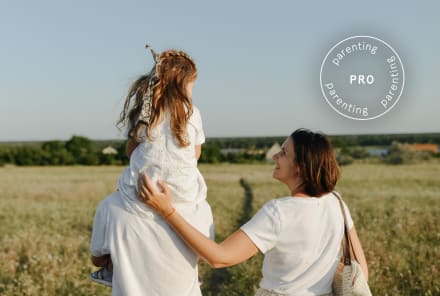Advertisement
How People Of All Ages Can Cope With Climate Distress & Anxiety


Talk of climate change tends to rely on fast, active verbs: We're told to fight and tackle, combat and sacrifice. As for the slower work of reflecting, processing, and integrating? That's largely left out of the conversation—potentially to the detriment of our mental health and our ability to take meaningful action in the first place.
How the psychological toll of climate change breeds inaction.
We suffer from some aspects of a warming world in real-time: Extreme heat and natural disasters can cause trauma and sudden displacement. Other dangers linger in the future, unseen but not unfelt. Projections of an apocalyptic future of food shortages, sea-level rise, and mass extinctions can lead to a nagging underlying sense of depression1 and eco-anxiety.
Climate change poses a unique threat to well-being, in part because of this simultaneous immediacy and distance.
"Climate change is a hyperobject, meaning it has vitality and coherence but it's so distributed through space and time that it is difficult to completely comprehend—perhaps impossible," Janet Lewis, M.D., a general psychiatrist who belongs to the Climate Psychiatry Alliance, a group of 500-odd mental health professionals drawing attention to the psychological burdens of climate change, tells mbg.
She explains that this perceived vastness can lead to disavowal, or the denial of responsibility. Faced with a problem so beyond our realm of understanding, it's only natural to respond with fear instead of action. In this sense, the climate crisis is in part a crisis of cognition.
"Traumatized individuals and groups exist in a fear-based self-protective survival mode that turns their focus inward, inhibits their ability to learn, and can all but eliminate their concern for the welfare of others or the natural environment," Bob Doppelt, Ph.D., writes in his book on how society can use climate change as an opportunity to learn and grow, Transformational Resilience.
"However," he adds, "when individuals and groups develop effective resilience skills, they are able to avoid personally or socially harmful reactions to adversity [...] and use trauma and stress as catalysts to actually increase their well-being above previous levels."
In short, resilience-building practices could help alleviate the psychological burden of climate change in the present and promote environmental progress in the future.
Here, environmentalists and mental health professionals weigh in on what those climate resilience practices could look like, how to best tailor them by age group, and how to integrate them into the fabric of our society so we can all move forward healthy, motivated, and dedicated to long-haul engagement.
Childhood: A time to open up the lines of communication & normalize emotions.
Most of the research on the mental health impacts of climate change on kids has focused on the trauma of living through a natural disaster. Hurricanes, floods, and extreme weather events are often a child's first exposure to climate change (even if they don't recognize them as such at the time) and can affect how that child grows up.
"Disasters really affect how children can see the world and shape their sense of the future," Betty Lai, Ph.D., a researcher at Boston College, tells mbg. Lai has done work monitoring how children cope with large-scale disasters like hurricanes. Though she says every child is different, some common reactions can include trouble sleeping, aggressive behavior, negative beliefs about the future, or dreams or flashbacks of the event.
To help children work through these post-traumatic stress symptoms, Lai says that giving them opportunities to talk about their feelings is key. Her research has found that parents and caretakers often assume that their child is feeling the same emotions they are feeling and might prefer not to talk about them. In reality, this isn't always the case, and silence can leave children with unresolved questions.
"Usually, children are relieved when you ask them how they're doing because they're holding those feelings and would like to get a chance to talk about it," she says. This can also reduce the likelihood that the child blames themselves for what happened.
"Sometimes, if you don't check in, children can invent what they think happened because they're trying to puzzle through it themselves. They need a little bit of adult help with that," Lai adds. "That's what makes children vulnerable in these disaster situations. They don't have as much experience with the world, and so they're trying to understand how these pieces fit together. Giving them a chance to ask questions can be really important."
Opening up the lines of communication can also help validate children's emotions. And ultimately, we don't have to wait until a disaster strikes to do it.
From Lai's perspective, the best way we can prepare children to grow up in a warming world is by providing plenty of avenues for them to safely talk about their feelings and teach them skills for coping with adverse events while maintaining a positive outlook.
School counselors and social workers are trained to do so, but they tend to be grossly underfunded. The American School Counselor Association recommends having one school counselor for every 250 children. It sounds like a low ratio to begin with, but it's one that only a couple of states consistently meet. Across most of the country, the average is closer to 1 counselor for every 464 students. To set up the next generation for success, we'll need to put more emotional support systems in place for them, at home and at school.
Adolescence: A time to balance the science of climate change with the art of dreaming and meaning-making.
Once we hit our teenage years, we start to get a sense of how climate change might affect us in the future, beyond our immediate lived experience. But most of us haven't yet developed the skills necessary to cope with this uncomfortable information. It's no surprise, then, that teenagers are now the most likely age group to report that anxiety about climate change gets in the way of their life.
According to a recent Blue Shield of California poll on 1,200 U.S. residents ages 14 to 24, 26% of them said that an environmental event or natural disaster has affected their ability to concentrate in school. Most of them also reported feeling as if their generation takes climate change more seriously than their parents' generation.
This is about slow action, slow change, slow hope, just like climate change is a form of slow violence.
Sarah Jaquette Ray, Ph.D., a professor of environmental studies at Humboldt University, has seen this generational burden of climate change play out in her classroom. "I think that young people feel like the work is so urgent that they need to be doing it 24/7," she tells mbg.
While Jaquette Ray acknowledges the crisis is urgent, she also recognizes the importance of slowing down and taking time for reflection, especially during adolescence. "This is about slow action, slow change, slow hope, just like climate change is a form of slow violence. The urgency is legitimate, but it's also a recipe for burnout."
It's a recipe for despair, too. Jaquette Ray recalls one class where she asked students to visualize living in a healthy, prosperous future where they are commended for their contributions to reversing climate change. When she asked them what it was that they were being commended for in the visualization, most of them admitted that they didn't complete the exercise. They couldn't even start to imagine what a healthy future would look like.
To assuage this sense of doom, Jaquette Ray says that the next generation needs to be encouraged to use their negative emotions to fuel their passions instead of stoke the fires of burnout: "Despair is a function of love... When we have these emotions, they're indicators. They're instructions for how to act."
Ultimately, fear and pain can inform action as much as joy can. Our job then becomes identifying what that action can be—where our unique skills and passions lie—and making meaning out of suffering. (Jaquette Ray's book, A Field Guide to Climate Anxiety, is a great resource for this type of self-inquiry.)
This is essential work at any age, but the younger we start doing it, the better. For this reason, Jaquette Ray thinks that the more emotional, heart-and-soul side of the climate crisis should be explored in school curricula and considered just as essential as scientific stats and projections.
Ideally, more educators would also encourage children of all ages to use the classroom as a space to imagine the future they'd like to inhabit. As Jaquette Ray says, "You can't put one foot in front of the other unless you know which direction you're going."
Adulthood: A time to find support and hope in community.
While the psychological toll of climate change might fade as we grow up, it certainly doesn't disappear.
"It's a huge stressor—but it's a stressor for different people in different ways," Lewis says of what she sees with her adult patients. Some are worried about the future of humanity; others are struggling to make decisions about whether to have children; others who have kids are confused about how to have climate conversations with them.
As a therapist, she feels it's her job to validate their concerns and help put them into a greater context. This is something that all therapists will have experience doing with other types of problems. However, Lewis does think that there are certain aspects of climate-specific distress that require an added layer of understanding and inquiry.
"Psychiatrists and other mental health professionals already have most of the skills for dealing with this," she says. "But it's a matter of extending those skills to here, to this point in history."
To help practitioners do so, the Climate Psychiatry Alliance is developing a climate-focused curriculum for medical students and psychiatric residents and encouraging the American Psychiatric Association to be a more forceful voice in climate conversations (they recently helped them start their first committee on climate change).
There aren’t sidelines on which to sit. We’re all part of this.
Lewis says this climate curriculum might touch on ways to address new forms of trauma, for example. "We typically think about trauma as existing in the past and inappropriately intruding on the present. But what if the trauma is in the present and the future?" Or it might cover how to help patients cope with solastalgia2, a relatively new term to describe the distress of watching your environment degrade over time.
It could also touch on medication issues that might become more common in a warming world. "A lot of our psychiatric medications can make people more sensitive to heat, and now we're having more and more intense heat waves," she explains. "So psychiatrists are going to have to be particularly attentive to heat effects."
Given the universal nature of climate change, Lewis hopes that the next wave of climate-literate therapists will be trained to administer their services in a group setting. "We're dealing with collective problems and collective solutions. We as individuals can't sit on the sidelines. There aren't sidelines on which to sit. We're all part of this," she says.
Discussing feelings in a group setting can also help people recognize that they're not alone and find strength in numbers. "It's easy to think, 'Well, if I can't see what I can do about this, then perhaps it's best not to think about it.' And that way of thinking has a huge blind spot because the collective can do things that individuals can't do," she says.
Ultimately, it all comes back to seeing the complexity of climate change not as an obstacle but as an opportunity. When the problem is so far-reaching, it opens the door to endless amounts of progress.
"The fact that the situations are uncertain means there's all this room for creative action," Lewis says.
Watch Next
Enjoy some of our favorite clips from classes
Enjoy some of our favorite clips from classes
What Is Meditation?
Mindfulness/Spirituality | Light Watkins
Box Breathing
Mindfulness/Spirituality | Gwen Dittmar
What Breathwork Can Address
Mindfulness/Spirituality | Gwen Dittmar
The 8 Limbs of Yoga - What is Asana?
Yoga | Caley Alyssa
Two Standing Postures to Open Up Tight Hips
Yoga | Caley Alyssa
How Plants Can Optimize Athletic Performance
Nutrition | Rich Roll
What to Eat Before a Workout
Nutrition | Rich Roll
How Ayurveda Helps Us Navigate Modern Life
Nutrition | Sahara Rose
Messages About Love & Relationships
Love & Relationships | Esther Perel
Love Languages
Love & Relationships | Esther Perel











